小学英语高年级阅读写作指导教学设计
小学英语阅读教学设计意图

注意事项:游戏设计要符合学生的年龄和认知水平,难度适中,能够吸引学生的注意力,同时也要注意游戏的纪律和安全。
教学过程
激活学生的前知:通过提问或讨论,回顾学生已学过的相关内容,为新课导入做准备 明确教学目标:向学生介绍本节课的学习目标,让学生有目的地进行学习 导入新课:通过故事、图片或情境等方式,吸引学生的注意力,引导学生进入新课的学习 准备阅读材料:向学生介绍即将阅读的文本,让学生对文本有初步的了解和认识
练习难度:根 据学生的实际 情况和教学目 标,设置不同 难度的练习题
理解阅读材料的主旨和要点 理解阅读材料的结构和逻辑关系 掌握阅读材料的语言知识和表达技巧 运用阅读材料进行语言输出和表达
教学方法
定义:通过创设真实、生动、具体的语言环境,激发学生学习兴趣,提高语言运用能 力。
目的:培养学生的英语思维能力和跨文化交际能力。
了解单词的词义和用法,能够区分 同义词和反义词
添加标题
添加标题
添加标题
添加标题
学会使用新词汇进行简单的英语交 流和表达
培养学生对英语词汇的兴趣和自主 学习能力
教学内容
内容:选择适合小学生英语水平的阅读材料,注重趣味性、知识性和教育意义。 难度:根据学生的英语水平和阅读能力,选择难度适中的阅读材料。 题材:涵盖自然、科学、文化、历史等方面的知识,丰富学生的阅读视野。 多样性:选择不同类型的阅读材料,如故事、科普文章、新闻等,提高学生的阅读兴趣。
添加标题
添加标题
添加标题
添加标题
学生参与度:观察学生在课堂上的 表现和参与情况
教师自我反思:对教学过程和效果 进行反思,总结经验和不足
基于学习活动观的小学英语阅读教学设计——以陕旅版小学英语教学为例
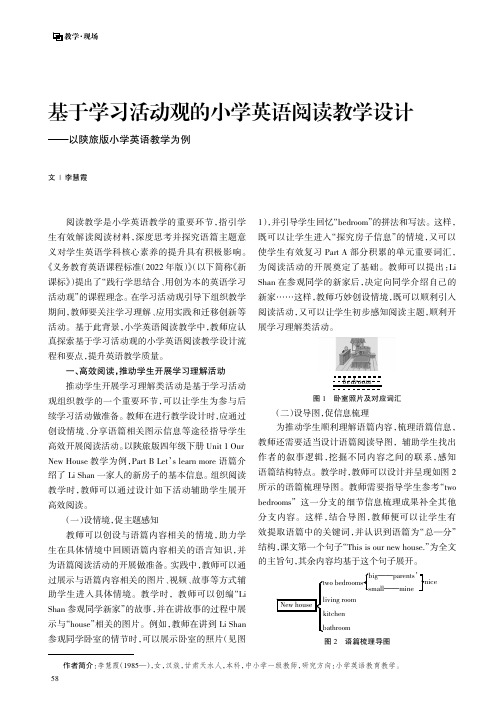
教学·现场基于学习活动观的小学英语阅读教学设计———以陕旅版小学英语教学为例文|李慧霞阅读教学是小学英语教学的重要环节,指引学生有效解读阅读材料,深度思考并探究语篇主题意义对学生英语学科核心素养的提升具有积极影响。
《义务教育英语课程标准(2022年版)》(以下简称《新课标》)提出了“践行学思结合、用创为本的英语学习活动观”的课程理念。
在学习活动观引导下组织教学期间,教师要关注学习理解、应用实践和迁移创新等活动。
基于此背景,小学英语阅读教学中,教师应认真探索基于学习活动观的小学英语阅读教学设计流程和要点,提升英语教学质量。
一、高效阅读,推动学生开展学习理解活动推动学生开展学习理解类活动是基于学习活动观组织教学的一个重要环节,可以让学生为参与后续学习活动做准备。
教师在进行教学设计时,应通过创设情境、分享语篇相关图示信息等途径指导学生高效开展阅读活动。
以陕旅版四年级下册Unit 1Our New House 教学为例,Part B Let ’s learn more 语篇介绍了Li Shan 一家人的新房子的基本信息。
组织阅读教学时,教师可以通过设计如下活动辅助学生展开高效阅读。
(一)设情境,促主题感知教师可以创设与语篇内容相关的情境,助力学生在具体情境中回顾语篇内容相关的语言知识,并为语篇阅读活动的开展做准备。
实践中,教师可以通过展示与语篇内容相关的图片、视频、故事等方式辅助学生进入具体情境。
教学时,教师可以创编“Li Shan 参观同学新家”的故事,并在讲故事的过程中展示与“house ”相关的图片。
例如,教师在讲到Li Shan 参观同学卧室的情节时,可以展示卧室的照片(见图1),并引导学生回忆“bedroom ”的拼法和写法。
这样,既可以让学生进入“探究房子信息”的情境,又可以使学生有效复习Part A 部分积累的单元重要词汇,为阅读活动的开展奠定了基础。
教师可以提出:Li Shan 在参观同学的新家后,决定向同学介绍自己的新家……这样,教师巧妙创设情境,既可以顺利引入阅读活动,又可以让学生初步感知阅读主题,顺利开展学习理解类活动。
小学英语教资阅读教学设计
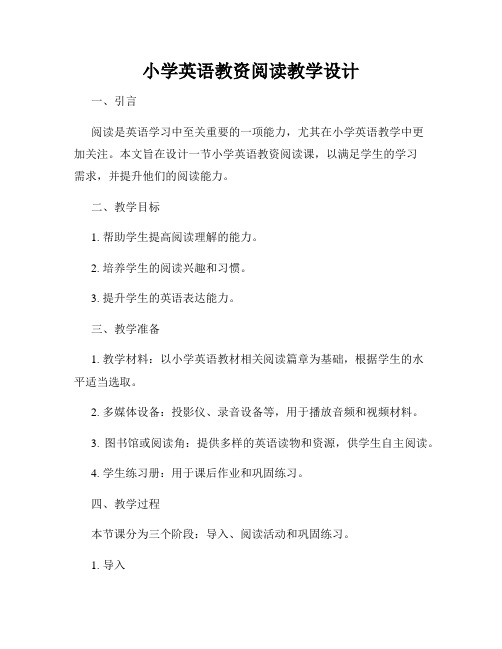
小学英语教资阅读教学设计一、引言阅读是英语学习中至关重要的一项能力,尤其在小学英语教学中更加关注。
本文旨在设计一节小学英语教资阅读课,以满足学生的学习需求,并提升他们的阅读能力。
二、教学目标1. 帮助学生提高阅读理解的能力。
2. 培养学生的阅读兴趣和习惯。
3. 提升学生的英语表达能力。
三、教学准备1. 教学材料:以小学英语教材相关阅读篇章为基础,根据学生的水平适当选取。
2. 多媒体设备:投影仪、录音设备等,用于播放音频和视频材料。
3. 图书馆或阅读角:提供多样的英语读物和资源,供学生自主阅读。
4. 学生练习册:用于课后作业和巩固练习。
四、教学过程本节课分为三个阶段:导入、阅读活动和巩固练习。
1. 导入教师可以通过播放一段与篇章主题相关的视频或音频来引起学生的兴趣。
同时,教师可以提问学生关于该主题的问题,激发他们的思考和讨论。
2. 阅读活动(1)前导活动教师可以通过展示一些与篇章内容相关的图片或单词,让学生预测文章的内容,并复习一些与主题相关的词汇。
(2)整体阅读教师同学生一起朗读篇章,逐句解读并讲解生词、短语或句子结构,帮助学生理解文章主旨和关键信息。
(3)细节理解教师可提出一些与篇章内容相关的问题,引导学生通过阅读找到答案。
可以进行小组合作或全班讨论,鼓励学生互相交流和分享自己的理解。
(4)阅读扩展教师鼓励学生通过阅读相关的资料或故事书籍,进一步拓展对主题的理解和知识。
3. 巩固练习教师可以设计一些与篇章内容相关的练习题,包括填空、选择、判断等形式,帮助学生巩固所学内容。
同时,可以要求学生以小组或个人形式撰写一篇短文,总结他们对篇章的理解和观点。
五、教学评估教师可以通过观察学生课堂表现、课后作业和个别交流等方式评估学生的阅读理解水平。
同时,教师也要注重对学生学习兴趣和参与度的评估,以便及时调整教学策略。
六、教学延伸教师鼓励学生积极参加校内外的英语阅读活动,如阅读比赛、阅读俱乐部等。
同时,可以推荐一些适合学生阅读的英语原版儿童读物,并组织讨论、分享和读书报告等活动,进一步培养学生的阅读兴趣和能力。
英语阅读课的教案范例

英语阅读课的教案范例一、教学目标本节课的教学目标旨在培养学生的英语阅读能力和理解能力,提高他们的词汇量和语法应用能力。
具体目标如下:1.学生能够熟练阅读并理解一篇趣味性的英语短文;2.学生能够通过阅读获得新的词汇和句型,并能够正确运用于实际情境中;3.学生能够运用推理和归纳的能力,整合文章中的信息并回答相关问题。
二、教学重点1.学生能够熟练阅读并理解英语短文;2.学生能够通过阅读获得新的词汇和句型;3.学生能够运用推理和归纳能力整合文章中的信息。
三、教学准备1.教师准备一篇趣味性的英语短文;2.教师准备相关的词汇和句型练习题;3.教师准备几个与文章相关的问题,用于学生的思考和讨论。
四、教学过程步骤一:导入1.向学生介绍本节课的教学目标,并简要解释为什么学习英语阅读是重要的;2.引发学生的兴趣:向学生展示一幅插画,让学生根据插画猜测故事情节。
步骤二:阅读理解1.教师朗读整篇短文,同时向学生展示短文的文字内容;2.学生自主阅读短文,并标注他们认为重要的信息和词汇;3.教师鼓励学生彼此交流,讨论短文内容,解答疑惑。
步骤三:词汇学习1.教师将短文中的生词和短语写在黑板上,并解释其意思;2.学生跟读并积极运用这些词汇和短语造句;3.教师提供相关的练习题,让学生巩固所学词汇和短语的应用能力。
步骤四:再阅读和思考1.学生再次阅读短文,尝试回答教师提出的问题;2.学生可自行思考和整理答案,也可与同学进行群体讨论;3.教师引导学生思考文章中的逻辑关系和引导词语的作用。
步骤五:总结和讨论1.教师与学生一起总结本节课的学习内容和所获得的收获;2.学生可以提出问题和分享自己的思考。
五、课后作业1.学生完成相关的词汇和句型习题;2.学生根据短文内容写一篇简短的读后感,并分享给同学。
六、教学反思本节课通过引导学生阅读一篇趣味性的英语短文,培养了他们的阅读能力和理解能力。
通过词汇学习和思考问题,学生不仅可以掌握新的词汇和句型,还可以锻炼他们的推理和归纳能力。
小学英文阅读指导教案模板

小学英文阅读指导教案模板一、教案基本信息- 学科:英语- 年级:小学 ___ 年级- 课时:___ 课时- 教材版本:人教版(或其他版本)- 教学目标:培养学生对英文阅读的兴趣,提高阅读理解能力。
二、教学内容- 主题:___ (例如:动物、自然、家庭等)- 文本:___ (例如:《The Cat in the Hat》、《Green Eggs and Ham》等)- 词汇:___ (列出本节课需要掌握的词汇)- 语法:___ (列出本节课需要掌握的语法点)三、教学目标1. 知识目标:- 学生能够理解文本的大意,掌握关键词汇和语法点。
- 学生能够运用所学知识进行简单的阅读和口语表达。
2. 能力目标:- 学生能够通过阅读提高英语思维能力和语言运用能力。
- 学生能够培养良好的阅读习惯和阅读兴趣。
3. 情感目标:- 学生能够喜欢英语阅读,感受阅读的乐趣。
- 学生能够培养合作精神,与他人分享阅读心得。
四、教学步骤1. 导入(5分钟):- 教师通过图片、歌曲、游戏等方式引导学生进入学习状态。
- 教师提出本节课的学习目标,激发学生的学习兴趣。
2. 文本阅读(15分钟):- 教师引导学生阅读文本,回答相关问题。
- 教师帮助学生理解文本大意,解释生词和语法点。
3. 活动一(10分钟):- 教师组织学生进行小组活动,讨论阅读心得。
- 学生通过角色扮演、绘制思维导图等形式巩固所学知识。
4. 活动二(10分钟):- 教师设计趣味性阅读任务,如阅读接力、阅读竞赛等。
- 学生通过完成任务,提高阅读速度和理解能力。
5. 总结与拓展(5分钟):- 教师对本节课所学内容进行总结,强调重点。
- 教师推荐相关阅读材料,激发学生的阅读兴趣。
五、作业布置- 学生完成课后阅读练习。
- 学生绘制文本故事情节图。
- 学生编写阅读心得体会。
六、教学反思教师在课后对教学效果进行反思,分析学生的学习情况,针对性地调整教学方法和策略。
{content}。
小学英语阅读教学设计意图
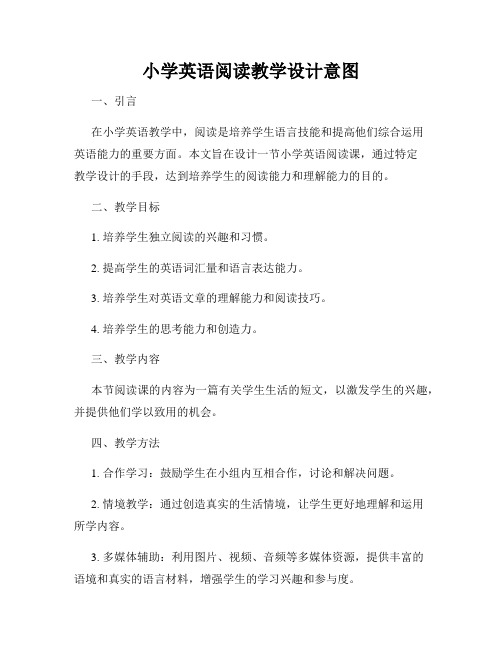
小学英语阅读教学设计意图一、引言在小学英语教学中,阅读是培养学生语言技能和提高他们综合运用英语能力的重要方面。
本文旨在设计一节小学英语阅读课,通过特定教学设计的手段,达到培养学生的阅读能力和理解能力的目的。
二、教学目标1. 培养学生独立阅读的兴趣和习惯。
2. 提高学生的英语词汇量和语言表达能力。
3. 培养学生对英语文章的理解能力和阅读技巧。
4. 培养学生的思考能力和创造力。
三、教学内容本节阅读课的内容为一篇有关学生生活的短文,以激发学生的兴趣,并提供他们学以致用的机会。
四、教学方法1. 合作学习:鼓励学生在小组内互相合作,讨论和解决问题。
2. 情境教学:通过创造真实的生活情境,让学生更好地理解和运用所学内容。
3. 多媒体辅助:利用图片、视频、音频等多媒体资源,提供丰富的语境和真实的语言材料,增强学生的学习兴趣和参与度。
五、教学步骤1. 导入:通过一些有趣的问题或图片引起学生的注意,并激发他们对即将学习的主题的兴趣。
2. 预读:给学生一些问题,让他们在阅读前先预测、猜测答案,以引发他们的思考。
3. 全文阅读:让学生通读短文,把握大意,并在必要时寻找关键词。
4. 细读:学生分组合作,根据问题和任务要求,深入理解文中的细节,回答问题或完成相关任务。
5. 讨论和分享:学生将自己的答案和观点与小组成员进行分享和讨论,并辅导老师进行必要的指导和点评。
6. 语言拓展:老师引导学生讨论文章中的词汇、短语和句型,并提供相关的语言知识和表达方式。
7. 写作训练:学生模仿短文的结构和语言,写一篇类似的短文,展示个人创造力和语言运用能力。
六、教学评估1. 学生的参与度:通过观察课堂上学生的参与和表现,评估他们在课堂上的积极程度和学习态度。
2. 学生的口头表达:通过学生在小组讨论和分享时的口头表达,评估他们对文章理解的准确性和流利程度。
3. 学生的书面表达:通过学生写作的表现,评估他们对所学语言知识的掌握和运用能力。
七、教学反思本节课通过多种教学方法和任务设计,旨在培养学生的阅读兴趣和能力。
小学英语PEP教材高段阅读教学设计与反思
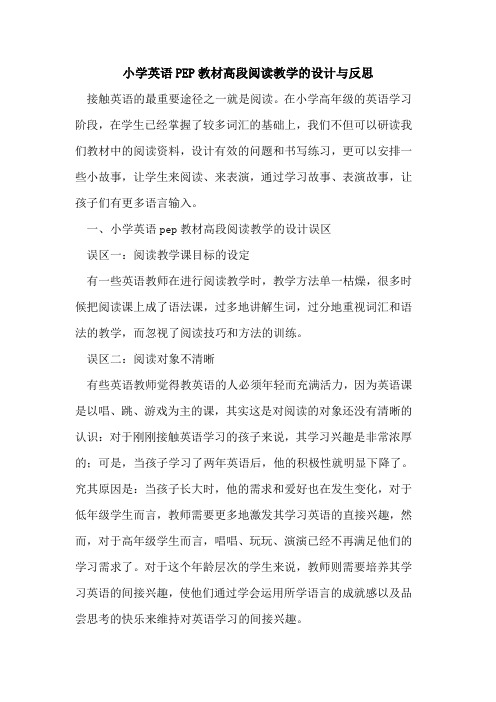
小学英语PEP教材高段阅读教学的设计与反思接触英语的最重要途径之一就是阅读。
在小学高年级的英语学习阶段,在学生已经掌握了较多词汇的基础上,我们不但可以研读我们教材中的阅读资料,设计有效的问题和书写练习,更可以安排一些小故事,让学生来阅读、来表演,通过学习故事、表演故事,让孩子们有更多语言输入。
一、小学英语pep教材高段阅读教学的设计误区误区一:阅读教学课目标的设定有一些英语教师在进行阅读教学时,教学方法单一枯燥,很多时候把阅读课上成了语法课,过多地讲解生词,过分地重视词汇和语法的教学,而忽视了阅读技巧和方法的训练。
误区二:阅读对象不清晰有些英语教师觉得教英语的人必须年轻而充满活力,因为英语课是以唱、跳、游戏为主的课,其实这是对阅读的对象还没有清晰的认识:对于刚刚接触英语学习的孩子来说,其学习兴趣是非常浓厚的;可是,当孩子学习了两年英语后,他的积极性就明显下降了。
究其原因是:当孩子长大时,他的需求和爱好也在发生变化,对于低年级学生而言,教师需要更多地激发其学习英语的直接兴趣,然而,对于高年级学生而言,唱唱、玩玩、演演已经不再满足他们的学习需求了。
对于这个年龄层次的学生来说,教师则需要培养其学习英语的间接兴趣,使他们通过学会运用所学语言的成就感以及品尝思考的快乐来维持对英语学习的间接兴趣。
误区三:设计过程缺乏对语言习得特点的正确把握学习语言的目的是为了满足现实生活中的真实需要,为了能够进行有意义的人际交流,不是为了学习语言本身去学习语言。
虽然兴趣是学生学习的关键,有了兴趣,学生才会觉得开心,学得轻松,才会愿意继续学习。
可是在许多英语教学设计中,教师以激发和培养学生的学习兴趣为出发点,创设多种形式,努力营造宽松、民主、和谐的教学氛围,但设计的教学活动多以游戏为主,刻意营造热闹的课堂氛围,设计的活动往往只重形式,不重实效。
二、小学英语pep教材高段阅读教学的设计策略策略一:英语阅读课教学目标的定位在分析英语阅读材料,设定教学目标时最重要的是要先分析好阅读材料,目的是在教学中突出重点、突破难点,提高教学效率。
中小学英语阅读教学设计

中小学英语阅读教学设计引言:英语阅读是培养学生语言能力和阅读能力的重要途径。
在中小学英语教学中,如何设计有效的英语阅读教学成为广大教师关注的焦点。
本文旨在探讨中小学英语阅读教学设计的相关策略和方法,以提升学生的阅读理解能力。
一、教学目标的设定在设计英语阅读教学时,首先需要明确教学目标,以便有针对性地开展教学活动。
教学目标可以分为知识目标、能力目标和情感目标三个层次。
知识目标包括学生掌握词汇、语法、句型等基础知识;能力目标包括学生的阅读理解能力、速读能力、推理能力等;情感目标则是培养学生对英语阅读的兴趣和积极的学习态度。
二、教学内容的选择在确定教学内容时,应根据学生的年龄、认知水平和语言水平进行合理选择。
可以结合教材内容,选取具有代表性的文本进行教学。
同时,可以引入与学生生活经验和兴趣相关的话题,以提升学生的学习动力。
此外,还可以根据学生的实际需求,选择一些实用性较高的文本,如广告、说明书等。
三、教学方法的运用在英语阅读教学中,教师应灵活运用一系列教学方法,以达到教学目标。
首先,可以采用预读和后读的方法,让学生在阅读之前通过预测和推测获取一些信息,在阅读之后进行总结和归纳。
其次,可以利用问答法、讨论法等互动方式激发学生的阅读兴趣,培养学生的思维能力和表达能力。
此外,教师还可以采用分层阅读法,根据学生的不同水平进行分组教学,以满足不同学生的需求。
四、教学策略的运用在英语阅读教学中,教师可以运用一些策略,帮助学生更好地理解文章。
例如,可以引导学生利用上下文推测生词的意思,培养学生的词汇猜测能力;可以通过阅读策略卡,让学生在阅读过程中有条理地整理信息;可以让学生用不同的方式呈现阅读理解结果,如绘画、写作、口头表达等。
五、教学评价的方法英语阅读教学不仅要关注教师的教学过程,还需要注重对学生学习效果的评价。
教师可以采用形成性评价和终结性评价相结合的方式进行评价。
形成性评价可以通过课堂教学观察、讨论互动等方式进行,及时发现并纠正学生的问题;终结性评价可以通过测试、作业等方式进行,客观、全面地评价学生的学习成果。
小学英语阅读课的教学设计

小学英语阅读课的教学设计几年前开始,小学英语的语篇教学已经成为非常重要的,讨论非常多的话题。
小学三、四年级可以看做发展英语阅读能力的准备阶段,多涉与词和句的认读阶段;到了五、六年级,小学英语教材中出现了显性的阅读语篇,怎样施教阅读课也开始为教师所关注。
而现大多数教师比较普遍的授课思路是:把阅读语篇看作教学口语或听力的素材,教师逐词逐句地解释和分析;反复放录音,直到学生能正确发音、熟练朗读并能完成课本上的阅读检测任务。
针对阅读教学中出现的这些问题,下面对小学高年级英语阅读教学发表一下我自己的观点。
首先,我们要对语篇教学的认识有一个初步的定位,教材的设计意图巩固拓展本单元的语法,不涉与新的语法知识。
阅读的目的是让学生理解阅读内容,培养学生的阅读能力。
例如,PEP教材六年级下册Unit1 PartB部分的Read and write。
这一部分的教学目标就是巩固拓展本单元的重点语法‘比较级’。
阅读课的教学步骤一般来讲,阅读理解要经历的心理过程是一个自下而上的过程和自上而下的过程。
前者针对词句的理解,后者则更多地运用了背景知识与推论等阅读技能。
因此,对语言能力低的读者而言,阅读与其说是一个阅读问题,到不如说是一个语言问题。
从这个意义上来讲,在小学高年级的英语阅读中,可按照“阅读前---阅读中---阅读后”的三步教学模式,即阅读前通过浏览预测语篇内容,而后从略读到精读多次阅读,不断确认或修订预测,直到理解所读语篇。
其中阅读中和阅读后两部分在实际操作中经常柔和在一起,呈现出“阅读---检测---再阅读---再检测”的过程。
在这个过程中教师可安排适当形式和难度的活动,即阅读前判断学生对语篇语言(词汇、语法)的理解情况,利用导读活动激活其原有的知识储备,解决其最主要的语言困难;阅读中着重培养学生正确的阅读行为和习惯,引导学生使用基本的阅读技巧,如运用背景知识,尝试联想、推论等;阅读后检测部分着眼于巩固、拓展相关语言知识,并促进与其他语言技能的融合。
小学英文阅读指导教案模板
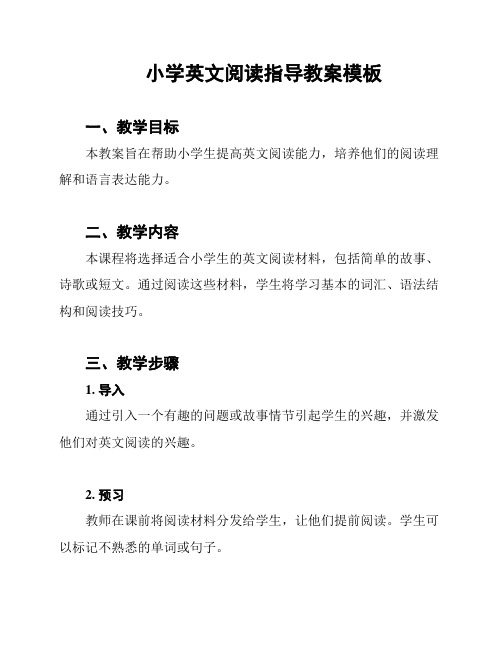
小学英文阅读指导教案模板一、教学目标本教案旨在帮助小学生提高英文阅读能力,培养他们的阅读理解和语言表达能力。
二、教学内容本课程将选择适合小学生的英文阅读材料,包括简单的故事、诗歌或短文。
通过阅读这些材料,学生将学习基本的词汇、语法结构和阅读技巧。
三、教学步骤1. 导入通过引入一个有趣的问题或故事情节引起学生的兴趣,并激发他们对英文阅读的兴趣。
2. 预习教师在课前将阅读材料分发给学生,让他们提前阅读。
学生可以标记不熟悉的单词或句子。
3. 阅读学生在课堂上朗读阅读材料,并尝试理解其中的内容。
教师可以提供适当的指导,帮助学生理解文章的主旨和细节。
4. 讨论教师与学生一起讨论阅读材料中的问题和观点。
学生可以分享自己的理解和观点,并与同学进行互动交流。
5. 语言拓展教师可以引导学生学习新的词汇和语法结构,以丰富他们的语言表达能力。
6. 写作练习学生可以根据阅读材料进行写作练习,包括写一篇文章、写一封信或进行简短的写作任务。
7. 总结教师与学生一起总结本节课的学习内容,并鼓励学生继续阅读和学习英文。
四、教学评估教师可以通过观察学生的阅读表现、听取学生的观点和评估学生的写作作品来评估他们的英文阅读能力。
五、教学资源教师准备合适的英文阅读材料、课堂讲义、词汇表等资源,以支持学生的学习。
六、教学延伸教师可以鼓励学生在课后继续阅读英文材料,并提供相关的阅读推荐和学习资源。
七、教学反思教师应及时反思教学过程,总结教学经验,并根据学生的实际情况进行相应的调整和改进。
以上为小学英文阅读指导教案模板,根据实际教学情况和学生的需求,可以适当调整和修改。
希望能对您的教学工作有所帮助!。
英语阅读课的教案范例
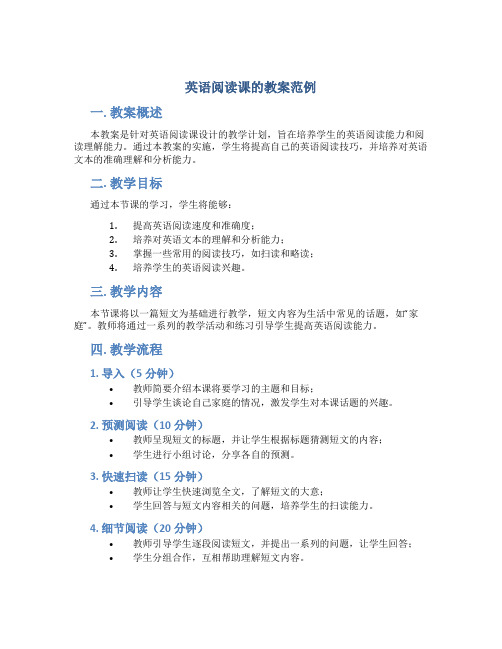
英语阅读课的教案范例一. 教案概述本教案是针对英语阅读课设计的教学计划,旨在培养学生的英语阅读能力和阅读理解能力。
通过本教案的实施,学生将提高自己的英语阅读技巧,并培养对英语文本的准确理解和分析能力。
二. 教学目标通过本节课的学习,学生将能够:1.提高英语阅读速度和准确度;2.培养对英语文本的理解和分析能力;3.掌握一些常用的阅读技巧,如扫读和略读;4.培养学生的英语阅读兴趣。
三. 教学内容本节课将以一篇短文为基础进行教学,短文内容为生活中常见的话题,如“家庭”。
教师将通过一系列的教学活动和练习引导学生提高英语阅读能力。
四. 教学流程1. 导入(5分钟)•教师简要介绍本课将要学习的主题和目标;•引导学生谈论自己家庭的情况,激发学生对本课话题的兴趣。
2. 预测阅读(10分钟)•教师呈现短文的标题,并让学生根据标题猜测短文的内容;•学生进行小组讨论,分享各自的预测。
3. 快速扫读(15分钟)•教师让学生快速浏览全文,了解短文的大意;•学生回答与短文内容相关的问题,培养学生的扫读能力。
4. 细节阅读(20分钟)•教师引导学生逐段阅读短文,并提出一系列的问题,让学生回答;•学生分组合作,互相帮助理解短文内容。
5. 理解与分析(15分钟)•教师引导学生对短文进行理解和分析,提出一些开放性问题供学生思考和讨论;•学生进行小组讨论,分享自己的观点和答案。
6. 小结与拓展(10分钟)•教师对课堂内容进行总结,强调学生在本节课中学到的重点知识和技巧;•教师布置相关阅读作业,加深学生对英语阅读的训练和应用。
五. 教学方法本节课采用多种教学方法,如导入讨论、小组合作、问题引导等方法,旨在激发学生的英语阅读兴趣,提高他们的阅读能力。
六. 教学评估本节课的教学评估主要通过以下几种方式进行:•学生在课堂上的积极参与程度;•学生在小组讨论和问题回答中的表现;•学生对文章内容的准确理解和分析能力。
七. 教学资源•短文《家庭》(准备足够的复印件供学生使用);•问题练习;•小组讨论指南。
人教版小学英语写作课教学设计
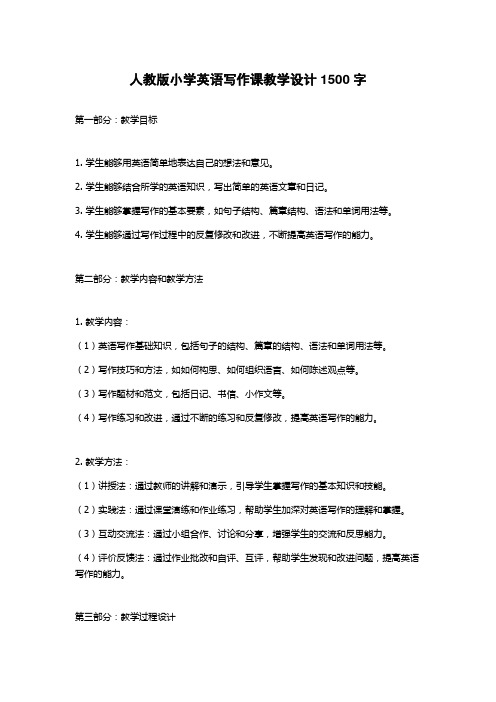
人教版小学英语写作课教学设计1500字第一部分:教学目标1. 学生能够用英语简单地表达自己的想法和意见。
2. 学生能够结合所学的英语知识,写出简单的英语文章和日记。
3. 学生能够掌握写作的基本要素,如句子结构、篇章结构、语法和单词用法等。
4. 学生能够通过写作过程中的反复修改和改进,不断提高英语写作的能力。
第二部分:教学内容和教学方法1. 教学内容:(1)英语写作基础知识,包括句子的结构、篇章的结构、语法和单词用法等。
(2)写作技巧和方法,如如何构思、如何组织语言、如何陈述观点等。
(3)写作题材和范文,包括日记、书信、小作文等。
(4)写作练习和改进,通过不断的练习和反复修改,提高英语写作的能力。
2. 教学方法:(1)讲授法:通过教师的讲解和演示,引导学生掌握写作的基本知识和技能。
(2)实践法:通过课堂演练和作业练习,帮助学生加深对英语写作的理解和掌握。
(3)互动交流法:通过小组合作、讨论和分享,增强学生的交流和反思能力。
(4)评价反馈法:通过作业批改和自评、互评,帮助学生发现和改进问题,提高英语写作的能力。
第三部分:教学过程设计1. 第一课时:英语写作基础(30分钟)(1)引导学生回忆所学的英语基础知识,包括基本的句型结构、语法和单词用法等。
(2)通过教师的讲解和演示,帮助学生理解英语写作的基本元素和要素。
(3)进行相关的练习和小测验,巩固所学的英语基础知识。
2. 第二课时:写作技巧和方法(40分钟)(1)通过课堂演示和互动交流,介绍写作的一些技巧和方法,如如何构思、如何组织语言、如何陈述观点等。
(2)教师演示一些写作技巧和方法,并对学生进行相关的实践操作。
(3)进行小组合作互动交流,分享自己的写作经验和体验。
3. 第三课时:写作题材和范文(50分钟)(1)通过教师的讲授和示范,介绍日记、书信、小作文等写作题材,并阅读相关的范文。
(2)通过学生自己的阅读和模仿,提高英语写作水平。
(3)通过小组合作和分享,提高学生的交流和合作能力。
指向高阶思维能力培养的小学英语阅读教学设计与思考
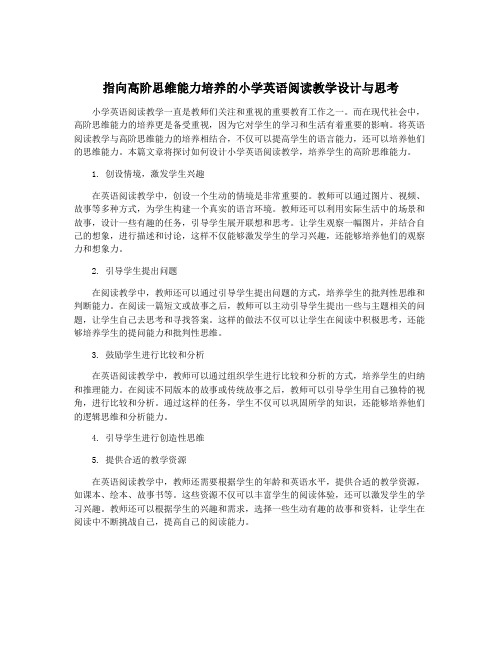
指向高阶思维能力培养的小学英语阅读教学设计与思考小学英语阅读教学一直是教师们关注和重视的重要教育工作之一。
而在现代社会中,高阶思维能力的培养更是备受重视,因为它对学生的学习和生活有着重要的影响。
将英语阅读教学与高阶思维能力的培养相结合,不仅可以提高学生的语言能力,还可以培养他们的思维能力。
本篇文章将探讨如何设计小学英语阅读教学,培养学生的高阶思维能力。
1. 创设情境,激发学生兴趣在英语阅读教学中,创设一个生动的情境是非常重要的。
教师可以通过图片、视频、故事等多种方式,为学生构建一个真实的语言环境。
教师还可以利用实际生活中的场景和故事,设计一些有趣的任务,引导学生展开联想和思考。
让学生观察一幅图片,并结合自己的想象,进行描述和讨论,这样不仅能够激发学生的学习兴趣,还能够培养他们的观察力和想象力。
2. 引导学生提出问题在阅读教学中,教师还可以通过引导学生提出问题的方式,培养学生的批判性思维和判断能力。
在阅读一篇短文或故事之后,教师可以主动引导学生提出一些与主题相关的问题,让学生自己去思考和寻找答案。
这样的做法不仅可以让学生在阅读中积极思考,还能够培养学生的提问能力和批判性思维。
3. 鼓励学生进行比较和分析在英语阅读教学中,教师可以通过组织学生进行比较和分析的方式,培养学生的归纳和推理能力。
在阅读不同版本的故事或传统故事之后,教师可以引导学生用自己独特的视角,进行比较和分析。
通过这样的任务,学生不仅可以巩固所学的知识,还能够培养他们的逻辑思维和分析能力。
4. 引导学生进行创造性思维5. 提供合适的教学资源在英语阅读教学中,教师还需要根据学生的年龄和英语水平,提供合适的教学资源,如课本、绘本、故事书等。
这些资源不仅可以丰富学生的阅读体验,还可以激发学生的学习兴趣。
教师还可以根据学生的兴趣和需求,选择一些生动有趣的故事和资料,让学生在阅读中不断挑战自己,提高自己的阅读能力。
冀教版小学英语阅读课教学设计
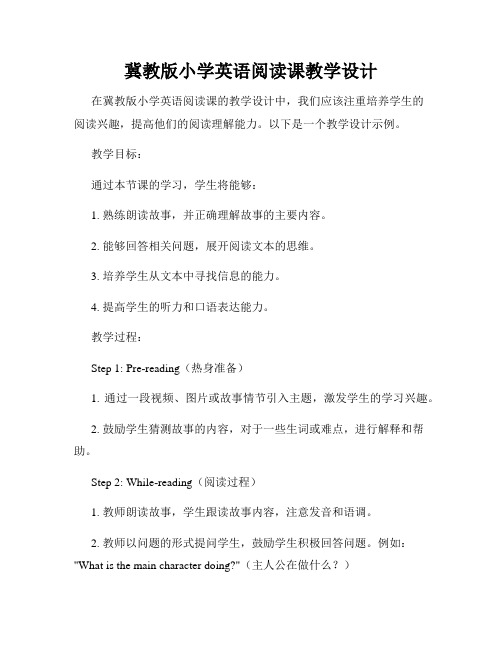
冀教版小学英语阅读课教学设计在冀教版小学英语阅读课的教学设计中,我们应该注重培养学生的阅读兴趣,提高他们的阅读理解能力。
以下是一个教学设计示例。
教学目标:通过本节课的学习,学生将能够:1. 熟练朗读故事,并正确理解故事的主要内容。
2. 能够回答相关问题,展开阅读文本的思维。
3. 培养学生从文本中寻找信息的能力。
4. 提高学生的听力和口语表达能力。
教学过程:Step 1: Pre-reading(热身准备)1. 通过一段视频、图片或故事情节引入主题,激发学生的学习兴趣。
2. 鼓励学生猜测故事的内容,对于一些生词或难点,进行解释和帮助。
Step 2: While-reading(阅读过程)1. 教师朗读故事,学生跟读故事内容,注意发音和语调。
2. 教师以问题的形式提问学生,鼓励学生积极回答问题。
例如:"What is the main character doing?"(主人公在做什么?)3. 学生根据问题和故事内容展开讨论,鼓励他们用完整的句子回答问题。
4. 教师指导学生在文本中寻找关键信息,并帮助他们理解故事的上下文。
Step 3: Post-reading(阅读后活动)1. 学生分小组进行讨论,分享他们对故事的理解和感受。
2. 学生可以选择角色扮演故事中的人物,展示对故事的理解。
3. 教师提供额外的阅读材料或问题,让学生进一步拓展他们的阅读理解能力。
4. 教师可以设计一些游戏活动,如填词游戏或故事连连看等,巩固学生对故事的理解。
Step 4: Extension(延伸活动)1. 学生可以根据故事内容,进行绘画或写作,表达他们对故事的理解和个人观点。
2. 学生可以在家庭作业中继续阅读相关的故事或文章,提高阅读的兴趣和能力。
3. 教师鼓励学生积极参与英语角或朗读比赛等活动,提高他们的口语表达能力。
通过这个教学设计,学生将能够在兴趣的驱使下,积极参与到阅读课堂中。
教师在设计过程中,应尽量多使用图片、视频等多媒体资源,以吸引学生的注意力。
小学英语阅读教学设计心得
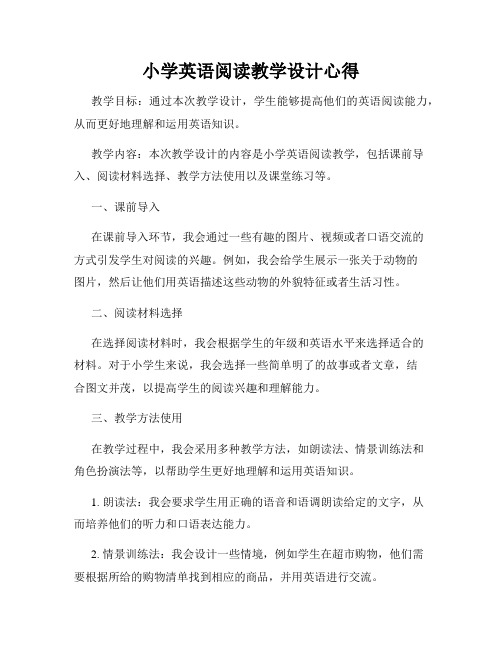
小学英语阅读教学设计心得教学目标:通过本次教学设计,学生能够提高他们的英语阅读能力,从而更好地理解和运用英语知识。
教学内容:本次教学设计的内容是小学英语阅读教学,包括课前导入、阅读材料选择、教学方法使用以及课堂练习等。
一、课前导入在课前导入环节,我会通过一些有趣的图片、视频或者口语交流的方式引发学生对阅读的兴趣。
例如,我会给学生展示一张关于动物的图片,然后让他们用英语描述这些动物的外貌特征或者生活习性。
二、阅读材料选择在选择阅读材料时,我会根据学生的年级和英语水平来选择适合的材料。
对于小学生来说,我会选择一些简单明了的故事或者文章,结合图文并茂,以提高学生的阅读兴趣和理解能力。
三、教学方法使用在教学过程中,我会采用多种教学方法,如朗读法、情景训练法和角色扮演法等,以帮助学生更好地理解和运用英语知识。
1. 朗读法:我会要求学生用正确的语音和语调朗读给定的文字,从而培养他们的听力和口语表达能力。
2. 情景训练法:我会设计一些情境,例如学生在超市购物,他们需要根据所给的购物清单找到相应的商品,并用英语进行交流。
3. 角色扮演法:我会让学生在小组内扮演不同的角色,根据给定的情境进行对话,从而提高他们的交际能力和英语口语表达能力。
四、课堂练习为了巩固学生的阅读能力,我会在课堂上设计一些练习题,如填空题、选择题和阅读理解题等。
这些练习题可以帮助学生更好地理解和运用所学的英语知识。
五、课后作业为了巩固学生在课堂上所学的知识,我会布置一些课后作业,如阅读一篇文章并回答问题、写一篇读后感等。
这些作业既可以加深学生对所学内容的理解,又可以培养他们的阅读习惯和写作能力。
六、教学反思在本次教学设计中,我发现学生对于阅读教学的兴趣逐渐增加,他们在阅读材料选择、教学方法使用以及课堂练习等方面都表现出了积极的态度。
然而,我也发现有些学生的阅读能力还有待提高,他们在理解文章意思和运用所学知识方面还存在困难。
因此,我将在以后的教学中继续关注并针对这些问题进行针对性的教学,以提高学生的阅读能力和英语综合应用能力。
小学英语阅读课教学设计模板范文
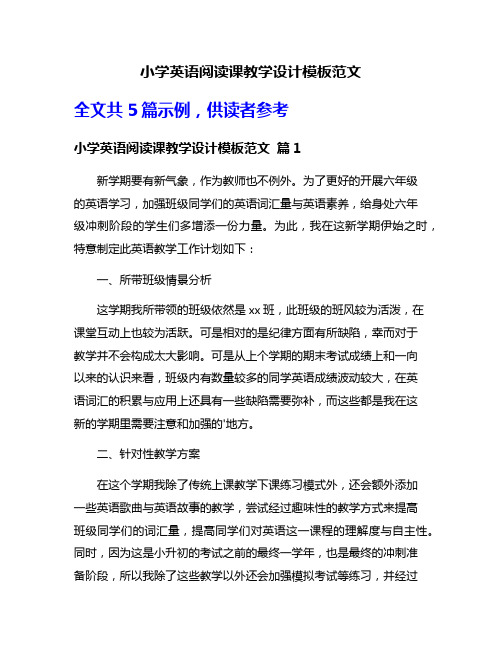
小学英语阅读课教学设计模板范文全文共5篇示例,供读者参考小学英语阅读课教学设计模板范文篇1新学期要有新气象,作为教师也不例外。
为了更好的开展六年级的英语学习,加强班级同学们的英语词汇量与英语素养,给身处六年级冲刺阶段的学生们多增添一份力量。
为此,我在这新学期伊始之时,特意制定此英语教学工作计划如下:一、所带班级情景分析这学期我所带领的班级依然是xx班,此班级的班风较为活泼,在课堂互动上也较为活跃。
可是相对的是纪律方面有所缺陷,幸而对于教学并不会构成太大影响。
可是从上个学期的期末考试成绩上和一向以来的认识来看,班级内有数量较多的同学英语成绩波动较大,在英语词汇的积累与应用上还具有一些缺陷需要弥补,而这些都是我在这新的学期里需要注意和加强的'地方。
二、针对性教学方案在这个学期我除了传统上课教学下课练习模式外,还会额外添加一些英语歌曲与英语故事的教学,尝试经过趣味性的教学方式来提高班级同学们的词汇量,提高同学们对英语这一课程的理解度与自主性。
同时,因为这是小升初的考试之前的最终一学年,也是最终的冲刺准备阶段,所以我除了这些教学以外还会加强模拟考试等练习,并经过研究历年考试真题来进行有针对性的考前培训,提高学生的答题技巧以及知识运用本事。
三、个人教学工作准备1、加强自身学习研究,经过历年的考试真题来对考试可能会出现的题型题目进行一些预测,并针对预测结果来进行教学准备,以提高学生的考试本事。
2、加强与孩子们的沟通交流,明白他们学习的难点在哪里,了解自我在教学中的不足并加以改正,力求经过这种方式来让我于班级同学融为一体,共同加强学习,共同为了提高而努力奋斗。
3、一个班级中总是有成绩的高低,所以我要发挥出教师的耐心与本事来悉心教导,不抛弃任何一个学生,督促先进生,鼓励后进生,引导整个班级学习风气的前进。
在新学期里,仅靠着我一人的努力是肯定不足的,我需要设法培养起学生们的学习热情,带动起全班同学们一齐努力,自发的向上才能够在激励的竞争中考取更好的学校,理解更好的教育,在以后成为一个对祖国、对人民有贡献的栋梁之才。
小学英语阅读课教学设计模板范文
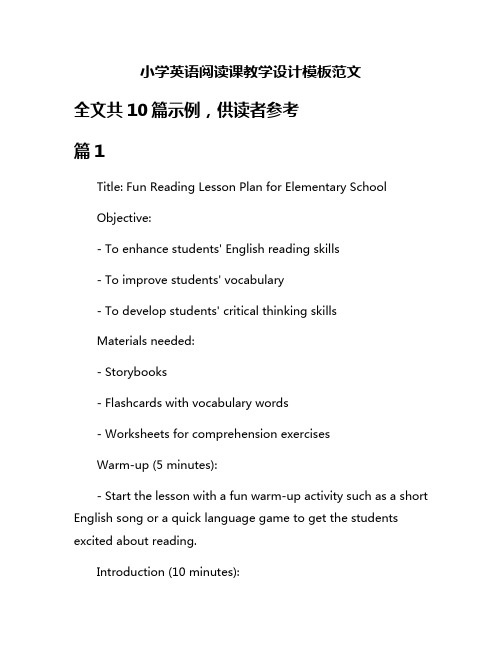
小学英语阅读课教学设计模板范文全文共10篇示例,供读者参考篇1Title: Fun Reading Lesson Plan for Elementary SchoolObjective:- To enhance students' English reading skills- To improve students' vocabulary- To develop students' critical thinking skillsMaterials needed:- Storybooks- Flashcards with vocabulary words- Worksheets for comprehension exercisesWarm-up (5 minutes):- Start the lesson with a fun warm-up activity such as a short English song or a quick language game to get the students excited about reading.Introduction (10 minutes):- Introduce the storybook to the students and talk about its title, author, and the main characters. Encourage students to make predictions about what the story might be about.Reading (15 minutes):- Read the story aloud to the students, pausing to explain any difficult words or concepts. Encourage students to follow along in their own copies of the storybook.Vocabulary (10 minutes):- Use flashcards to introduce and review key vocabulary words from the story. Have students practice saying the words aloud and use them in sentences.Comprehension exercises (15 minutes):- Distribute worksheets with comprehension questions related to the story. Have students work individually or in pairs to answer the questions and discuss their answers.Discussion (10 minutes):- Lead a class discussion about the story, asking students to share their thoughts on the plot, characters, and themes. Encourage students to ask questions and express their opinions.Wrap-up (5 minutes):- Review the main points of the lesson and remind students of the importance of reading in English. Assign homework such as reading another storybook or writing a short summary of the lesson.Conclusion:This lesson plan is designed to make reading fun and engaging for elementary school students. By incorporating interactive activities and discussions, students will not only improve their English reading skills but also develop a love for reading.篇2Title: Fun Reading Lesson Plan for Elementary School StudentsHi guys! Today, I'm gonna share with you a super fun reading lesson plan for our English class. Are you ready? Let's dive in!Objective:- To improve students' reading comprehension skills- To enhance students' vocabulary and language abilities- To foster a love for reading and learningMaterials:- Storybooks (fiction and nonfiction)- Flashcards with new vocabulary words- Worksheets for comprehension exercises- Colorful markers or pencilsWarm-up (5 minutes):Let's start our lesson with a quick warm-up activity! I'll show you some flashcards with new words. Repeat after me and try to remember the meanings of the words. Are you ready?Reading Session (20 minutes):Now it's time for the main part of our lesson – reading! I'll read a story aloud to you first, and then we'll read it together. Pay attention to the characters, events, and details in the story. Let's have some fun with it!Comprehension Exercise (10 minutes):After reading the story, we'll do a comprehension exercise together. I'll ask you some questions about the story to checkyour understanding. Don't worry, you can always refer back to the text for help!Vocabulary Expansion (10 minutes):Let's learn some new words from the story! I'll write down the words on the board and explain their meanings. You can also use them in sentences to practice using them in context.Creative Activity (10 minutes):To wrap up our lesson, we'll do a fun creative activity related to the story we read. It could be drawing, writing a short story, or acting out a scene from the story. Let your imagination run wild!Discussion and Reflection (5 minutes):Before we end our lesson, let's have a quick discussion about the story and share our thoughts and feelings. What did you like most about the story? What did you learn from it? Let's reflect on our reading experience together.Homework (5 minutes):Your homework for today is to read a short story of your choice at home and write a summary of it. Don't forget to jot down any new words you come across and their meanings. Have fun reading!That's it for our reading lesson today, guys! I hope you had a blast and learned something new. Remember, reading is not just a task, it's an adventure! See you next time! Bye-bye!篇3Title: English Reading Lesson Plan for Elementary School StudentsHello, everyone! Today, we are going to have a fun English reading lesson. Are you all ready? Great! Let's get started with our lesson plan.1. Introduction (5 minutes)- Begin the lesson by greeting the students and asking them how they are feeling.- Review any vocabulary or concepts that will be covered in the reading passage.- Explain the importance of reading in English and why it is important to practice reading regularly.2. Pre-Reading Activities (10 minutes)- Introduce the reading passage and discuss the title, author, and genre.- Show students the cover of the book or reading material and ask them to predict what the story might be about.- Engage students in a brief discussion about any similar stories or experiences they have had related to the reading material.3. Reading Comprehension (20 minutes)- Read the passage aloud to the students, pausing at key points to ask comprehension questions.- Encourage students to follow along as you read, and to ask questions if they do not understand something.- After reading the passage, have students summarize the main points and identify any new vocabulary or concepts they learned.4. Post-Reading Activities (15 minutes)- Engage students in a discussion about the theme of the reading passage and how it relates to their own lives.- Have students work in pairs or small groups to create a short skit or play based on the reading material.- Encourage students to share their skits with the class and discuss the characters, plot, and moral of the story.5. Extension Activities (10 minutes)- Play a vocabulary game related to the reading passage, such as a word search or crossword puzzle.- Have students write a short paragraph summarizing their favorite part of the story and why they enjoyed it.- Give students the opportunity to ask any remaining questions or share their thoughts on the reading material.6. Conclusion (5 minutes)- Recap the main points of the lesson and thank the students for their participation.- Encourage students to continue practicing their reading skills outside of the classroom.- Assign any homework or reading assignments related to the lesson for students to complete before the next class.That's it for today's English reading lesson! I hope you all had fun and learned something new. See you next time! Bye!篇4Title: Fun English Reading Class for Elementary StudentsIntroduction:Hey guys, today I'm going to share with you a super cool lesson plan for an English reading class, specially designed for elementary students. Are you ready to have some fun while learning English? Let's get started!Objective:The main objective of this lesson is to improve students' English reading comprehension skills through fun and engaging activities.Materials Needed:- Storybooks or reading passages- Flashcards with key vocabulary words- Worksheets with comprehension questions- Whiteboard and markers- Props or pictures related to the storyWarm-up Activity:To start off the class, we can play a game of "Simon Says" using English commands. This will help students review basic vocabulary and get them excited for the lesson.Main Activity:1. Reading Aloud:Choose a storybook or reading passage that is suitable for the students' reading level. Read the story aloud to the class, pausing to explain key vocabulary words and asking comprehension questions along the way.2. Acting Out the Story:After reading the story, divide the students into groups and assign each group a part of the story to act out. Encourage them to use props or pictures to bring the story to life. This will help students better understand the plot and characters of the story.3. Comprehension Questions:Distribute worksheets with comprehension questions related to the story. Have students work individually or in pairs to answer the questions. This will test their understanding of the story and help them practice their reading skills.4. Vocabulary Practice:Use flashcards with key vocabulary words from the story to review with the students. Play games like matching the word to the picture or charades to reinforce the meaning of the words.Closure:To wrap up the lesson, have a discussion with the students about their favorite part of the story and what they learned from the reading. Encourage them to share their thoughts and feelings about the characters and events in the story.Conclusion:I hope you all had a blast learning English through reading today! Remember, reading is a great way to improve your language skills and expand your knowledge. Keep reading and practicing, and you'll become fluent in English in no time. Great job, everyone!篇5Title: Fun Reading Class Teaching PlanHello everyone, today I'm going to share with you a fun reading class teaching plan. Let's get started!1. Title: My Favorite Animal- Introduction: Introduce the topic by asking students to share their favorite animals.- Vocabulary: Learn new words related to animals such as "paws", "feathers", "hooves", etc.- Reading: Read a short passage about different animals and their characteristics.- Comprehension: Ask questions about the passage to check understanding.- Activity: Draw and color their favorite animal, then share with the class.2. Title: A Day at the Beach- Introduction: Discuss what students like to do at the beach.- Vocabulary: Learn new words like "sandcastle", "sunscreen", "seashells", etc.- Reading: Read a story about a day at the beach and the fun activities involved.- Comprehension: Ask questions about the story to assess comprehension.- Activity: Create a summer beach scene using paper, stickers, and markers.3. Title: The Magical Forest- Introduction: Talk about magical creatures like unicorns, fairies, and dragons.- Vocabulary: Learn new words like "enchanted", "mysterious", "magical", etc.- Reading: Read a fantasy story set in a magical forest with mythical creatures.- Comprehension: Ask questions to check understanding of the story.- Activity: Create a magical forest diorama using art supplies and craft materials.4. Title: My Dream Vacation- Introduction: Discuss where students would like to go on vacation.- Vocabulary: Learn new words related to travel such as "passport", "souvenir", "adventure", etc.- Reading: Read a travel brochure describing different vacation destinations.- Comprehension: Ask questions about the brochure to test understanding.- Activity: Write a postcard from their dream vacation spot and illustrate it.Remember to keep the class engaging and interactive by incorporating games, songs, and group activities. I hope you have fun learning English through reading in our class! See you next time!篇6Title: Fun and Interactive English Reading Lesson Plan for Elementary SchoolHello everyone! Today, I am going to share with you a super cool English reading lesson plan that will make learning fun and interesting. Let's get started!Lesson Title: Let's Read and Have Fun!Objective:- To improve students' English reading skills.- To enhance students' comprehension abilities.- To cultivate students' interest in reading.Materials Needed:- Storybooks or short stories- Flashcards with vocabulary words- Reading comprehension worksheetsWarm-up activity:Start the lesson by playing a quick vocabulary game with flashcards. Show the students a flashcard with a word on it and have them guess the meaning. This will help activate their prior knowledge and get them excited for the reading.Main Activity:1. Introduce the story or short story you will be reading to the students.2. Read the story aloud to the students while displaying the text on a projector or board.3. Pause at certain points to ask comprehension questions and engage with the students.4. After reading the story, have the students work on reading comprehension worksheets based on the story. This will help reinforce their understanding of the text.5. Divide the students into pairs or small groups and have them discuss the story and share their favorite parts with each other.6. To make the lesson more interactive, you can also have a role-play activity where students act out scenes from the story.7. End the lesson with a fun reading-related game like a word search or crossword puzzle.Assessment:- Observe students' participation and engagement during the lesson.- Evaluate students' understanding of the story through their answers on the reading comprehension worksheets.- Provide feedback to students on their reading skills and comprehension abilities.Extension Activity:Encourage students to borrow storybooks from the school library and read at home. Have them write a short summary or book review to share with the class in the next lesson.With this fun and interactive English reading lesson plan, I hope you and your students will enjoy reading and learning together. Have a great time exploring the wonderful world of English stories!篇7Title: Fun Reading Lesson Plan for Elementary School StudentsIntroductionHey everyone! Today, we are going to have a super fun reading lesson! We will read a cool story and learn some new words. Are you ready? Let's get started!ObjectiveBy the end of this lesson, you will be able to:1. Understand the main idea of the story2. Identify new vocabulary words3. Answer questions about the storyMaterials- Storybook: "The Adventures of Tommy and Lily"- Whiteboard and markers- Flashcards with new vocabulary words- Question cardsWarm-Up (5 minutes)Let's start with a quick warm-up! I'll say a word, and you shout out the first thing that comes to your mind. Ready? "Apple!" (Students shout out different fruits). Great job, everyone!Reading the Story (15 minutes)Now, let's read our story "The Adventures of Tommy and Lily." As I read, listen carefully and try to imagine the characters and scenes in your mind. After we finish reading, we will discuss the story together.Vocabulary Practice (10 minutes)Next, we will learn some new words from the story. I will show you a flashcard with a word, and you have to guess the meaning. For example, if I show you the word "chase," you can say "run after something." Let's practice together!Comprehension Questions (10 minutes)After learning new words, I will ask you some questions about the story. Who were the main characters? What did they do in the story? Why do you think they acted that way? Let's see how well you remember the story!Group Activity (10 minutes)Now, let's do a fun group activity! I will divide you into groups and give each group a question card. You have to discuss the question with your group members and come up with an answer. Then, one member will share your answer with the class. Let's see how well you can work together!Conclusion (5 minutes)Great job, everyone! I'm so proud of how well you did in today's reading lesson. You listened attentively, learned new words, and answered questions about the story. Keep practicing your reading skills, and you will become even better readers in no time!That's the end of our fun reading lesson for today. I hope you had a great time. See you next time, and keep up the good work! Bye-bye!篇8Title: My English reading lesson planHi everyone! Today I'm going to tell you about a super fun English reading lesson plan that you can use in your classroom. This lesson plan is designed for elementary school students andwill help them improve their reading skills while having a great time.Step 1: Warm-up (5 minutes)To start the lesson, we will do a fun warm-up activity to get the students excited about reading. You can start by having the students do a quick review of the vocabulary words they have learned in previous lessons. Then, you can play a game like "Simon Says" using English commands to get the students moving and engaged.Step 2: Introduce the story (10 minutes)Next, introduce the story that the students will be reading. Choose a story that is appropriate for their reading level and interests. You can show them the cover of the book and ask them to make predictions about what the story might be about. Encourage the students to think about the characters, setting, and plot.Step 3: Reading comprehension (15 minutes)After introducing the story, have the students read the story either independently or in pairs. While they are reading, encourage them to pay attention to the main events in the story and the feelings of the characters. After they have finishedreading, ask comprehension questions to check their understanding of the text. You can also have them summarize the story in their own words.Step 4: Vocabulary review (10 minutes)After the students have finished reading the story, review any new vocabulary words that they encountered. Have them practice using the words in sentences or come up with synonyms and antonyms for the words. This will help reinforce their understanding of the vocabulary and improve their language skills.Step 5: Extension activities (15 minutes)To wrap up the lesson, you can have the students do a fun extension activity related to the story. This could be a creative writing task where they write a new ending for the story, arole-playing activity where they act out a scene from the story, or a drawing activity where they illustrate their favorite part of the story. This will help the students engage with the text in a creative way and further develop their language skills.That's it for my English reading lesson plan! I hope you try it out in your classroom and have a blast reading with yourstudents. Remember, the key to a successful reading lesson is to make it engaging, interactive, and fun. Happy reading!篇9Title: Fun Reading Lesson Plan for Primary SchoolHey guys! Today I'm going to share with you a super fun English reading lesson plan for primary school. Let's get started!1. Title: Let's Read Together2. Objective: By the end of the lesson, students will be able to read and comprehend a short story in English.3. Materials needed:- Storybooks- Flashcards with key vocabulary- Whiteboard and markers- Worksheets for activities4. Warm-up (10 mins):Start the lesson by playing a game of Simon Says using English commands. This will get the students engaged and ready to learn.Introduce the story to the students and show them the cover of the book. Ask them what they think the story is about.6. Reading (15 mins):Read the story out loud to the students, making sure to use expressive intonation and gestures to keep them engaged. Pause at key points to ask comprehension questions.7. Vocabulary (10 mins):Introduce key vocabulary from the story using flashcards. Have students repeat the words after you and use them in sentences.8. Comprehension Activities (15 mins):Have students work in pairs or small groups to answer comprehension questions about the story. Then, have them act out a scene from the story.9. Extension Activities (10 mins):For higher-level students, provide additional reading materials related to the story for them to read independently. Have them write a short summary of the story.Review key vocabulary and concepts from the lesson. Have students share their favorite part of the story.That's it for today's lesson! I hope you have fun reading together and learning new English words. See you next time! Bye!篇10Title: My English Reading Lesson PlanHey everyone! Today I'm going to share with you my awesome English reading lesson plan. Are you ready? Let's get started!1. Introduction- Greet the class and introduce the topic of the lesson.- Get the students excited about reading and learning new words.2. Warm-up- Start with a fun warm-up activity like a vocabulary game or a quick review of the previous lesson.- Engage the students and get them ready to learn.- Choose a short story or a passage that is suitable for the students' level.- Divide the text into smaller sections and have the students read aloud.- Encourage the students to ask questions and discuss the story as they read.4. Comprehension questions- After reading the story, ask the students comprehension questions to check their understanding.- Encourage the students to think critically and express their opinions.5. Vocabulary- Introduce new words from the story and explain their meanings.- Have the students practice using the new words in sentences.- Play word games or do vocabulary exercises to reinforce learning.- Ask the students to write a short summary of the story or their favorite part.- Encourage creativity and originality in their writing.7. Extension activities- If time allows, you can do a fun activity related to the story like a role play or a creative art project.- Make learning enjoyable and interactive for the students.8. Conclusion- Wrap up the lesson by reviewing the key points and praising the students for their hard work.- Encourage the students to keep reading and learning English.That's it for my English reading lesson plan! I hope you found it helpful and inspiring. Remember, reading is fun and a great way to improve your English skills. Keep reading and keep learning! See you next time!。
核心素养下的小学英语高年级阅读教学

核心素养下的小学英语高年级阅读教学基于《义务教育英语课程标准 (2011 年版)》中提出的综合语言运用能力,小学英语核心素养主要分为语言能力,思维品质,文化品格和学习能力四个方面。
将核心素养融入小学英语高年级阅读课中,需要教师充分理解文本,依据文本主线和高年级学生的认知特征,设计合理的教学活动,从而促进学生的综合语言运用能力,提升英语核心素养。
本文以外研社新标准英语 (三年级起) 五年级 (下) Module7 Unit1 My father goes to work at eight o’clock every morning.为例,探究小学英语高年级阅读教学策略。
一、深度解读文本,教学设计“依生而定”。
本节课授课对象为五年级学生,他们已经学了两年多的英语,掌握了不少的词汇,可以用英语进行简单的交流,对与一般现在时的第三人称形式有一定的理解,因此,本节课对于语法知识教学以复习巩固为主。
《义务教育英语课程标准(2011 年版)》在语言技能二级目标中提出学生能借助图片读懂简单的故事或小短文,并养成按意群阅读的习惯,这就要求学生能理解文本的主要内容,并能以有意义的短句为单位来阅读,而不是一个词一个词地读。
但在实际的教学中,学生很难按意群阅读,对整体语篇意识感不强,理解只停留在文本表面。
而且有部分五年级学生对英语学习的兴趣没有一开始接触英语时的高涨了,如何提高学生的学习兴趣也是教学中教师需要关注的地方。
二、合理设计活动,核心素养“融入其中”根据教材的解读以及五年级学生的认知特点,我采用读前活动(Pre-reading),读中活动(While-reading),读后活动(Post-reading)三个步骤,在学生阅读过程中融入核心素养,提高他们的综合语言运用能力。
读前活动(Pre-reading)主要是为了激活学生已有的与本课有关的旧知识,同时活跃课堂气氛,激发学生的学习兴趣,引导学生进入英语学习中。
设计合理的Pre-reading为接下来的读中活动(While-reading)作扎实的铺垫,使学生的阅读更加的准确和高效。
人教版小学课本英语阅读教学设计
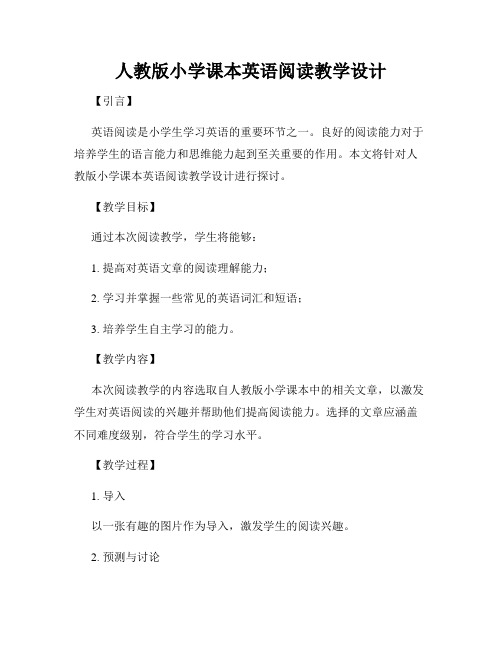
人教版小学课本英语阅读教学设计【引言】英语阅读是小学生学习英语的重要环节之一。
良好的阅读能力对于培养学生的语言能力和思维能力起到至关重要的作用。
本文将针对人教版小学课本英语阅读教学设计进行探讨。
【教学目标】通过本次阅读教学,学生将能够:1. 提高对英语文章的阅读理解能力;2. 学习并掌握一些常见的英语词汇和短语;3. 培养学生自主学习的能力。
【教学内容】本次阅读教学的内容选取自人教版小学课本中的相关文章,以激发学生对英语阅读的兴趣并帮助他们提高阅读能力。
选择的文章应涵盖不同难度级别,符合学生的学习水平。
【教学过程】1. 导入以一张有趣的图片作为导入,激发学生的阅读兴趣。
2. 预测与讨论通过观察图片,学生进行预测和讨论,猜测文章的主题和内容,培养他们的猜测能力和思考能力。
3. 阅读与理解教师给学生发放课本,让学生独立阅读文章,并回答相关问题,从而提高他们的阅读理解能力。
4. 单词学习与拓展针对文章中出现的生词和短语,进行适当的词汇讲解和拓展。
教师可以通过图片、实物等多种形式进行教学,增强学生的记忆和理解能力。
5. 听力训练通过听力训练,帮助学生提高听力理解能力,培养他们对语音和语调的敏感度。
可以使用录音机或多媒体设备来播放相关听力材料。
6. 合作学习将学生分成小组进行合作学习,鼓励他们在小组内互相讨论和交流,共同解决阅读中遇到的问题,并分享彼此的理解和体会。
这样可以促进学生之间的互动和合作意识。
7. 写作练习让学生根据所学的文章内容进行写作练习,可以是写一篇感想、撰写一篇类似的故事等。
通过写作能够锻炼学生的语言表达能力和思维逻辑能力。
8. 总结与评价教师与学生一起总结本次阅读教学的收获和体会,并给予学生适当的评价和肯定,激励他们持续学习。
【教学评估】教师可以通过观察学生在教学过程中的表现、听写、练习册等方式进行综合评估。
通过评估,了解学生的学习情况,发现问题并给予及时的指导和帮助。
【教学延伸】学校可以组织英语阅读角、课外英语阅读俱乐部等活动,鼓励学生积极参与英语阅读,并提供更多的阅读资源给学生。
- 1、下载文档前请自行甄别文档内容的完整性,平台不提供额外的编辑、内容补充、找答案等附加服务。
- 2、"仅部分预览"的文档,不可在线预览部分如存在完整性等问题,可反馈申请退款(可完整预览的文档不适用该条件!)。
- 3、如文档侵犯您的权益,请联系客服反馈,我们会尽快为您处理(人工客服工作时间:9:00-18:30)。
Dick was not old, but he does not have much hair. His wife Emma has thick, beautiful black hair. They have a son. His name is Peter, and he is five years old. One day, Dick was reading a book in his study. Peter looked at his father for a long time and then said to his mother, “Why does Papa have so little hair, Mama?” Emma laughed and said, “He has little hair because he thinks a lot. He’s a very clever man.” Peter looked at his mother’s thick black hair for a few seconds and then said, “Then I know why you have so much hair.”I Read carefully and write “T” for True and “F” for False beside the statements.( ) 1 Dick is five years old. ( ) 2 Dick has much hair.( ) 3 Dick’s wife has much hair. ( ) 4 Dick is a very clever man.( ) 5 Emma has so much hair because she isn’t a clever woman.II Choose the best answer to these questions.( ) 1 Dick is Peter’s ____. A mother B father C sister D brother( ) 2 Dick has ____hair. A no B beautiful C a little D long( ) 3 Emma has ____hair. A no B short C long D thick( ) 4 Emma says Dick is a ____man. A little B strong C foolish D clever( ) 5 Peter thinks that Emma is ____. A nice B foolish C clever D kindIII Fill in the blanks according to the meanings.1 She is too ___________ to ride a bicycle. 她太小了,不能骑脚踏车。
2 ____________do you like winter? 你为什么喜欢冬天?3 I _____________you are very brave. 我认为你非常勇敢。
4 Don’t ______________at me. 不要嘲笑我。
5 Last winter the snow lay _______________on the ground.去年冬天,地上积雪很厚。
Nasreddin put two big baskets of grapes on his donkey and went to the market.At midday it was very hot,so he stopped in the shade of a big tree.There were several other men there, and all of them had donkeys of grapes too.After their lunch they went to sleep. After some time,Nasreddin began to take grapes out of the other men's baskets and put them in his. Suddenly one of the men woke up and saw him.What are you doing? He said angrily. Oh,said Nasreddin,don't worry about me.I am half mad, and I do a lot of strange things. Oh,really?said the other man.Then why don't you sometimes take grapes out of your baskets and put them in somebody else's baskets? You did not understand me,said Nasreddin.I said that I was half mad, not quite mad.( )1.Nasreddin went to market_______.A. to sell his donkeyB. to buy somethingC. to sell his grapesD. to find a job( ) 2. Nasreddin stopped______.A.under a big treeB.near a big treeC.around a big treeD.in a big tree( )3.As Nasreddin was taking away the other men's grapes , one of the men_______.A.pretended not to see himB. saw him and got angryC.woke his fellows upD.came at him ( )4.Nasreddin said that he did a lot of strange things because_______.A.he was cleverB. he was quite madC.he was foolishD.he was half mad( )5.In this story Nasreddin was ______.A.a selfish manB.a strange manC.a friendly manD.a foolish manA judge was working in his room one day when a neighbour ran in and said,If one man's cow kills another's, is the owner of the first cowresponsible? It depends, answered the judge. Well,said the man,your cow has killed mine. Oh,answered the judge.Everyone knows that a cow cannot think like a man,so a cow is not responsible,and that means that its owner is not responsible either. I am sorry,Judge,said the man.I made a mistake.I meant that my cow killed yours. The judge thought for a few seconds and then said,When I think about it more carefully,this case is not as easy as I thought at first. And then he turned to his clerk and said. Please bring me that big blackbook from the shelf behind you.( )1.The neighbour asked the judge_______.A.whether the first cow was responsibleB.whether the owner of the first cow was responsibleC.whether both cows were responsibleD.whether both the owners were responsible( )2.When the neighbour reported that his cow had killed the judge’s, the judge answered that______.A.a cow was reponsibleB. its owner was not responsibleC.neither a cow nor its owner was responsibleD.his cow was responsible( )3.When the neighbour heard this, he told the judge that_______.A.there was nothing happenedB. his cow had been killedC.it was his cow that had killed the judge'sD.both cows had been killed( )4.When the judge heard that his cow had died, he________.A..got angryB.said nothingC.put his neighbor into prisonD.changed what he had said at first ( )5.In this story the judge was______. A. a clever judge B.a humorist C.unfair D.foolish 【日积月累】1 ride the tiger2 black and blue3 go in one ear and out the other4 Far from eye, far from heart.5 He sets the fox to keep the geese.6 Kill two birds with one stone.7 Like father, like son8 Love me, love my dog.9 Many heads are better than one.10 Misfortunes never come alone.11 No cross, no crown.12 Nothing brave, nothing have.13 One boy is a boy, two boys half a boy, three boys no boy.14 Rome is not built in a day.15 Tall trees catch much wind.。
